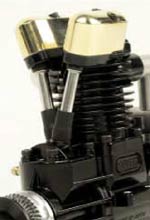 |
| The new cam housing is a recent design change for the Saito line; it contributes to the FA-40a's overall lighter weight and increases its power-to-weight ratio. | APPLICATIONS
Any model that can be powered by a .20 to .40 2-stroke engine might be a good candidate for the FA-40a. One of Horizon's product specialists suggested that Lanier's .25 Extra would be a good match. Most kit and ARF specs give both the 2-stroke and the 4-stroke engine size recommendations, and it is always best to go by the plane manufacturer's recommendation.
The smallest plane in my stable is a Sig Four-Star 40. I tried the FA-40a in it to see how it performs (see the "Flight Test" sidebar), but for now, let's do some break-in runs on the test stand and get to know the new kid.
BREAK-IN AND BENCH TESTING
To summarize the break-in procedure given in the manual, you shouldn't exceed 4,000rpm during the first 10 minutes of operation. After that, gradually lean it out with each tank of fuel, and always maintain a rich mixture until you've accrued 40 minutes of run time. This worked well, and after this regimen, my test engine held full power without slowing down or becoming overheated. Then, as instructed, I moved the idle needle to the setting that produced an excellent idle and transition to high speed. The owner's manual gives detailed break-in procedures for both bench and flight break-in methods, so it's always a good idea to read and follow the instructions for the break-in method you choose.
|
THE SAITO .30, .40 AND .50 LINEUP
The FA-40a doesn't fit the same mount as the FA-30; it has a slightly larger mountingbolt pattern. This engine isn't a remake of an existing product; the dimensions of its new design fall between those of the .30 and the .50.
Here's a comparison of the major specs of the .30, .40, and .50 from the manual (note the high power-to-weight ratio of the new .40). |
|
ENGINE |
.30 |
.40 |
.50 |
|
DISTANCE, PROP DRIVE HUB TO BACK OF CARB (IN.) |
3.35 |
3.46 |
4.10 |
|
OVERALL HEIGHT (IN.) |
3.46 |
3.66 |
4.10 |
|
OVERALL WIDTH (IN.) |
1.69 |
1.77 |
2.13 |
|
WEIGHT W/MUFFLER (OZ.) |
9.17 |
10.58 |
15.34 |
|
POWER (HP) |
0.50 |
0.65 |
0.85 |
|
POWER-TO-WEIGHT RATIO (HP/LB.) |
0.87 |
0.98 |
0.89 |
|
TYPICAL SPORT PROP |
10x5 |
11x6 |
12x6 | |
The manual recommends a fuel nitro content of 10 to 15 percent. I like 15 percent because I've found through the years that I can run just about any glow engine on that nitro fuel ratio with little compromise in performance. With so many different models in my fleet, I like the convenience! Although this works well for me, I encourage you to use the type of fuel recommended by the manufacturer of the specific engine.
CONCLUSION
Since the new .40 falls between the existing .30 and .50-size engines, the increment in power choices is narrowed again. The 40a's high power-to-weight ratio makes it an attractive choice for those who like the option of installing more power without a weight penalty in a model that's designed to use a .30-size 4-stroke. I found this engine generally easy to start and adjust, user friendly and without bad habits or surprises-just like its larger stablemates in the Saito line.
The new FA-40a reflects the continuing evolution and refinement of Saito's basic design, and it incorporates years of design refinements and continues the line's tradition of high quality and value. If you install and adjust this engine properly, you will never be hassled by deadstick landings and, as a bonus, you'll get that great 4-stroke sound from a small package!
FLIGHT TEST
I installed the FA-40a in a well-worn Sig Four-Star 40 and attached an APC 11x5 prop. This plane has hosted about six engines in its long life, and it's showing signs of stress with the many cheek cowl cutouts. I filled the tank with Cool Power 15-percent-nitro fuel, and the plane weighed 5.4 pounds ready to fly. Du-Bro threaded brass inserts are installed on the front of the firewall, and I used them to secure the engine rather than using the blind nuts that are installed from the back. With this setup, I don't have to remove the tank when I fit a new engine for testing, however, with so many inserts, the firewall does look like Swiss cheese.
Takeoff on thick grass took only slightly longer than the other engines I have tested in the Four-Star 40, and the climb-out was moderate and stable. As my confidence in the engine increased, I gradually upped the flight load with aerobatics that included inside and outside loops, snaps, inverted flight and then the supreme test: knife-edge and hover. The knife-edge was brief; I could hold it for only about 100 feet before the plane began to lose altitude, and the hover quickly ended up in a tailslide.
For about 15 minutes, I shot many approaches at a dead low idle, made touch-and-go's, inverted approaches and flybys, all with instant throttle response for a reliable climb-out. This was just pure fun! I tried to force the engine to falter with a lower and lower idle and then snapping the stick to full throttle, but it was solid all the way. For the second flight I had to land and taxi in the rain, but during both flights, the Saito FA-40a earned my respect
Now I call it the "little engine that could." The Saito FA-40a delivered a solid performance that would certainly satisfy the first-time low-wing flier and even many all-around sport fliers who are just getting into aerobatics. | |